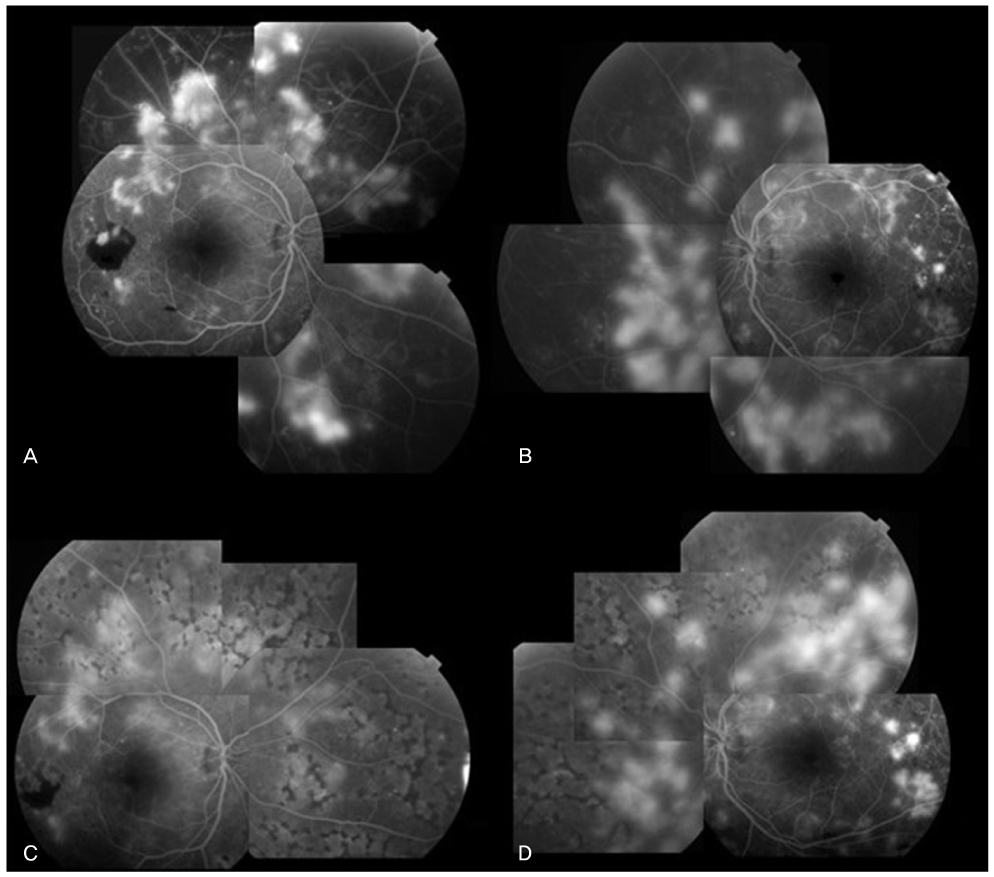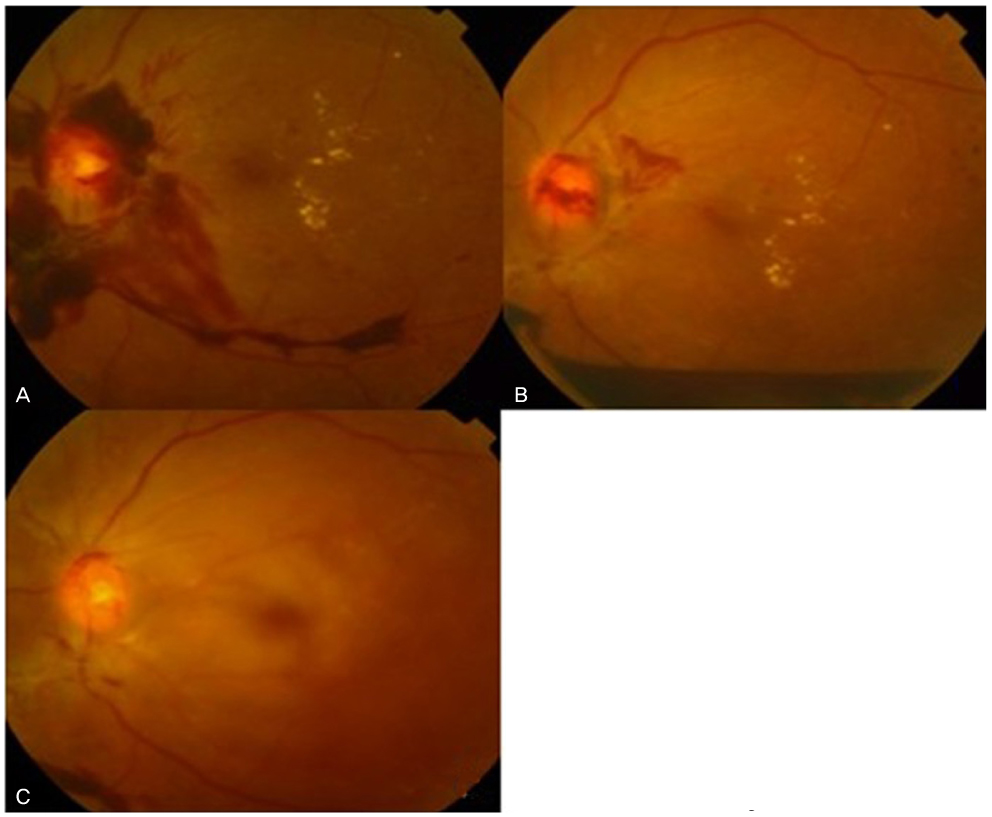Korean J Ophthalmol.
2009 Dec;23(4):266-272. 10.3341/kjo.2009.23.4.266.
Effects of an Intravitreal Bevacizumab Injection Combined With Panretinal Photocoagulation on High-Risk Proliferative Diabetic Retinopathy
- Affiliations
-
- 1Department of Ophthalmology, Hanyang University College of Medicine, Seoul, Korea. hycho@hanyang.ac.kr
- KMID: 754761
- DOI: http://doi.org/10.3341/kjo.2009.23.4.266
Abstract
- PURPOSE
To investigate the short-term effects of panretinal photocoagulation (PRP) combined with an intravitreal injection of Avastin(R) (bevacizumab) as an adjuvant to high-risk proliferative diabetic retinopathy (PDR).
METHODS
The data was collected retrospectively from the eyes of high-risk PDR patients, which were divided into two groups. One eye was treated with only PRP (PRP only group) and the fellow eye of same patient was treated with both PRP and intravitreal bevacizumab injection (Adjuvant group). Best corrected visual acuity (BCVA), IOP (intraocular pressure), and new vessel (NV) size in fluorescein angiography were recorded immediately and at the six-week follow-up visit. Adverse events associated with intravitreal injection were investigated.
RESULTS
Of 12 patients with high-risk PDR, five were male and seven were female. There were no statistically significant BCVA or IOP changes after treatment in either group (p=0.916, 0.888). The reduction of NV size was found in both groups, but NV size in the adjuvant group showed a greater decrease than that of the PRP only group (p=0.038). Three patients had adverse events after intravitreal injection. Two patients had mild anterior uveitis and one patient had a serious complication of branched retinal artery obstruction (BRAO).
CONCLUSIONS
Intravitreal bevacizumab injection with PRP resulted in marked regression of neovascularization compared with PRP alone. One serious side effect, BRAO, was noted in this study. Further studies are needed to determine the effect of repeated intravitreal bevacizumab injections and the proper number of bevacizumab injections as an adjuvant.
Keyword
MeSH Terms
-
Angiogenesis Inhibitors/*administration & dosage
Antibodies, Monoclonal/*administration & dosage
Diabetic Retinopathy/diagnosis/*therapy
Female
Fluorescein Angiography
Follow-Up Studies
Fundus Oculi
Humans
Injections
Laser Coagulation/*methods
Male
Middle Aged
Retrospective Studies
Risk Factors
Treatment Outcome
Vascular Endothelial Growth Factor A/antagonists & inhibitors
Vitreoretinopathy, Proliferative/diagnosis/*therapy
Vitreous Body
Figure
Reference
-
1. Kaiser RS, Maguire MG, Grunwald JE, et al. One-year outcomes after panretinal photocoagulation in proliferative diabetic retinopathy. Am J Ophthalmol. 2000. 129:178–185.2. Early photocoagulation for diabetic retinopathy: ETDRS report number 9. Early Treatment Diabetic Retinopathy Study Research Group. Ophthalmology. 1991. 98:5 Suppl. 766–785.3. Kleiner RC, Elman MJ, Murphy RP, Ferris FL 3rd. Transient severe visual loss after panretinal photocoagulation. Am J Ophthalmol. 1988. 106:298–306.4. McDonald HR, Schatz H. Macular edema following panretinal photocoagulation. Retina. 1985. 5:5–10.5. Flynn HW Jr, Chew EY, Simons BD, et al. Pars plana vitrectomy in the Early Treatment Diabetic Retinopathy Study. EDTRS report number 17. The Early Treatment Diabetic Retinopathy Study Research Group. Ophthalmology. 1992. 99:1351–1357.6. Aiello LP, Avery RL, Arrigg PG, et al. Vascular endothelial growth factor in ocular fluid of patients with diabetic retinopathy and other retinal disorders. N Engl J Med. 1994. 331:1480–1487.7. Murata T, Nakagawa K, Khalil A, et al. The relation between expression of vascular endothelial growth factor and breakdown of the blood-retinal barrier in diabetic rat retinas. Lab Invest. 1996. 74:819–825.8. Funatsu H, Yamashita H, Noma H, et al. Aqueous humor levels of cytokines are related to vitreous levels and progression of diabetic retinopathy in diabetic patients. Graefes Arch Clin Exp Ophthalmol. 2005. 243:3–8.9. Yang JC, Haworth L, Sherry RM, et al. A randomized trial of bevacizumab, an anti-vascular endothelial growth factor antibody, for metastatic rectal cancer. N Engl J Med. 2003. 349:427–434.10. Avery RL, Pearlman J, Pieramici DJ, et al. Intravitreal bevacizumab (Avastin) in the treatment of proliferative diabetic retinopathy. Ophthalmology. 2006. 113:1695–1705.11. Jorge R, Costa RA, Calucci D, et al. Intravitreal bevacizumab (Avastin) for persistent new vessels in diabetic retinopathy (IBEPE study). Retina. 2006. 26:1006–1013.12. Grading diabetic retinopathy from stereoscopic color fundus photographs: an extension of the modified Airlie House classification. ETDRS Report No. 10. Ophthalmology. 1991. 98:5 Suppl. 786–806.13. Rosenfeld PJ, Moshfeghi AA, Puliafito CA. Optical coherence tomography findings after an intravitreal injection of bevacizumab (Avastin) for neovascular age-related macular degeneration. Ophthalmic Surg Lasers Imaging. 2005. 36:331–335.14. Rosenfeld PJ, Moshfeghi AA, Puliafito CA. Optical coherence tomography findings after an intravitreal injection of bevacizumab (Avastin) for macular edema from central retinal vein occlusion. Ophthalmic Surg Lasers Imaging. 2005. 36:336–339.15. Oshima Y, Sakaguchi H, Gomi F, Tano Y. Regression of iris neovascularization after intravitreal injection of bevacizumab in patients with proliferative diabetic retinopathy. Am J Ophthalmol. 2006. 142:155–158.16. Ehlers JP, Spirn MJ, Lam A, et al. Combination intravitreal bevacizumab/panretinal photocoagulation versus panretinal photocoagulation alone in the treatment of neovascular glaucoma. Retina. 2008. 28:696–702.17. Tonello M, Coast TA, Almeida FP, et al. Panretinal photocoagulation versus PRP plus intravitreal bevacizumab for high-risk proliferative diabetic retinopathy (IBeHi study). Acta Ophthamol. 2008. 86:385–389.18. Mirshahi A, Roohipoor R, Lashay A, et al. Bevacizumab-augmented retinal laser photocoagulation in proliferative diabetic retinopathy: a randomized double-masked clinical trial. Eur J Ophthalmol. 2008. 18:263–269.19. Aiello LM. Perspectives on diabetic retinopathy. Am J Ophthalmol. 2003. 136:122–135.20. Soheilian M, Ramezani A, Bijanzadeh B, et al. Intravitreal bevacizumab (avastin) injection alone or combined with triamcinolone versus macular photocoagulation as primary treatment of diabetic macular edema. Retina. 2007. 27:1187–1195.21. Haritoglou C, Kook D, Neubauer A, et al. Intravitreal bevacizumab (Avastin) therapy for persistent diffuse diabetic macular edema. Retina. 2006. 26:999–1005.22. Bakri SJ, Larson TA, Edwards AO. Intraocular inflammation following intravitreal injection of bevacizumab. Graefes Arch Clin Exp Ophthalmol. 2008. 246:779–781.23. Shima C, Sakaguchi H, Gomi F, et al. Complications in patients after intravitreal injection of bevacizumab. Acta Ophthalmologica. 2008. 86:372–376.24. Scappaticci FA, Skillings JR, Holden SN, et al. Arterial thromboembolic events in patients with metastatic carcinoma treated with chemotherapy and bevacizumab. J Natl Cancer Inst. 2007. 99:1232–1239.25. Hurwitz H, Saini S. Bevacizumab in the treatment of metastatic colorectal cancer: safety profile and management of adverse events. Semin Oncol. 2006. 33:S26–S34.
- Full Text Links
- Actions
-
Cited
- CITED
-
- Close
- Share
- Similar articles
-
- Long-term Effect of Panretinal Photocoagulation Combined With Intravitreal Bevacizumab in High-risk Proliferative Diabetic Retinopathy
- Short-term Effect of Intravitreal Bevacizumab Injection Preventing Panretinal Photocoagulation-Induced Macular Edema in Proliferative Diabetic Retinopathy
- Retinal Vascular Caliber Changes in Diabetic Retinopathy after Panretinal Photocoagulation and Additive Bevacizumab Injections
- Tractional Retinal Detachment After Intravitreal Bevacizumab (Avastin(R)) Injection in Proliferative Diabetic Retinopathy
- Ruptured Retinal Arterial Macroaneurysm after Panretinal Photocoagulation for Diabetic Retinopathy




